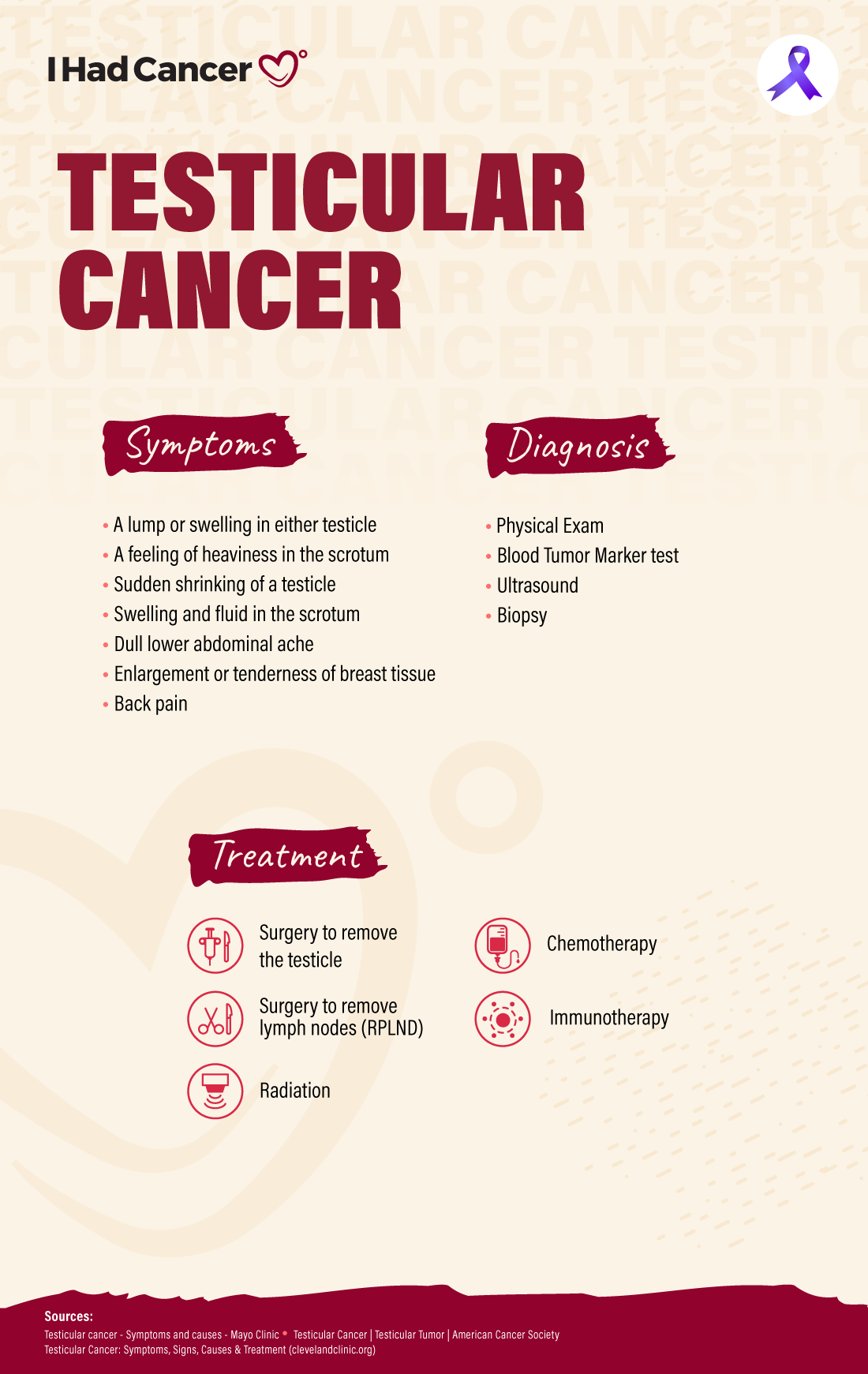Learn about different types of cancer through IHadCancer's "Cancer 101" series. Scroll down for information on Testicular Cancer & where to find support if you are a cancer thriver.
What is Testicular Cancer?
The testicles are two oval-shaped male reproductive organs that produce testosterone and sperm for reproduction. They are located in the scrotum, a loose bag of skin that is located behind the penis.
Testicular cancer results from the abnormal growth of cells in the tissues of one or both testicles.
Testicular cancer is not a common type of cancer but can happen at any age - typically between the ages of 15 and 45. About 1 out of every 250 men will be diagnosed with testicular cancer. This type of cancer has several successful treatment options.
What are some risk factors for Testicular Cancer?
- Having an undescended teste(s)
- Having a family history of testicular cancer
- Having testicular cancer previously
- Congenital testicular abnormality
- Abnormal precancerous cells in the testicle (GCNIS: germ cell neoplasia in situ)
What are the best ways to prevent Testicular Cancer?
Always perform TSE (Testicular Self-Exams) monthly to identify changes in your testicles. Testicular cancer can be linked to the above risk factors, but there are no ways to avoid those genetic risk factors. Early detection leads to the best outcomes for testicular cancer patients.
How to Perform a Testicular Self-Exam:
- Do the exam during or after bathing, as the warmer the scrotum is the easier the exam will be.
- Gently roll one side of the scrotum with your fingers to feel the surface of the testicle.
- Check for unusual textures (lumps, bumps, or swelling that may or may not be painful).
- The front of the testicle should be smooth and lump-free. The back of the testicle should feel like a soft collection of tubes, where the testicles collect and carry sperm.
- Make note of soreness or heaviness in the testicle.
- Switch to the other side of the scrotum and repeat the exam.
- While doing this monthly exam, keep track of whether the testicle is changing in size over time. Check every month while doing this exam to see if the testicle changes in size over time.
What are some symptoms of Testicular Cancer?
- A lump or swelling in either testicle
- A feeling of heaviness in the scrotum
- Sudden shrinking of the testicle
- Swelling and collection of fluid in the scrotum
- Dull ache in the lower abdomen
- Enlargement or tenderness of breast tissue
- Back pain
How is Testicular Cancer diagnosed?
Testicular is one of few cancers where a biopsy results in complete removal of the testicle rather than just removal of cells from the affected/swollen area of the testicle.
- Physical Exam: Checking for the presence of lumps in the testicles.
- Blood Test: Tumor Marker Test detects the presence of proteins made by testicular cancer cells.
- Ultrasound: Determines the location of any testicular lumps.
- Biopsy: If cancer is suspected, the entire affected testicle must be removed for a biopsy.
What are the most common types of Testicular Cancer?
- Seminoma Testicular Cancer: A slow-growing tumor that mostly affects people in their 40s or 50s
- Nonseminoma Testicular Cancer: A rapidly growing tumor that mostly affects people in their late teens, 20s, and 30s
What are typical treatments for Testicular Cancer?
Treatments for testicular cancer vary from patient to patient, but some of the most common ones are:
- Radical Inguinal Orchiectomy: Surgery to remove the testicle
- Retroperitoneal Lymph Node Dissection (RPLND): If there is concern that your cancer may have spread beyond your testicle, you may have surgery to remove some lymph nodes. The provider makes an incision in your abdomen and removes the lymph nodes behind your abdominal organs.
- Chemotherapy
- Radiation
- Immunotherapy
Testicular Cancer Infographics:
Click images for a larger view and to download.
 |  |
IHadCancer Testicular Cancer Community Member Blogs:
- How Having Testicular Cancer Gave Me a New Life’s Mission
- Men Deserve To Have Their Health Taken Seriously
- This Young Adult Survivor Didn't Let Cancer Get In The Way of His Degree
- Why You Shouldn't Be Afraid of the RPLND Surgery for Testicular Cancer
- I Almost Died Pretending I Didn't Have Cancer
I'm a Testicular Cancer Fighter/Survivor/Thriver, and I need support. Where do I go?
Some organizations that provide financial and/or mental health support for the Testicular Cancer community are:
- Testicular Cancer Foundation
- Testicular Cancer Society
- Movember (Focus on Testicular & Prostate Cancers)
Testicular Cancer Awareness:
April is Testicular Cancer Awareness Month and the color is Orchid (purple/violet). Raise awareness by participating in local events and sharing your story. If you'd like to share your story on IHadCancer.com, email blog@ihadcancer.com.








Team I Had Cancer is the group of people behind the scenes, making sure IHadCancer.com is running, and that you're connecting to the people you need to know for the support and information you need while dealing with cancer.